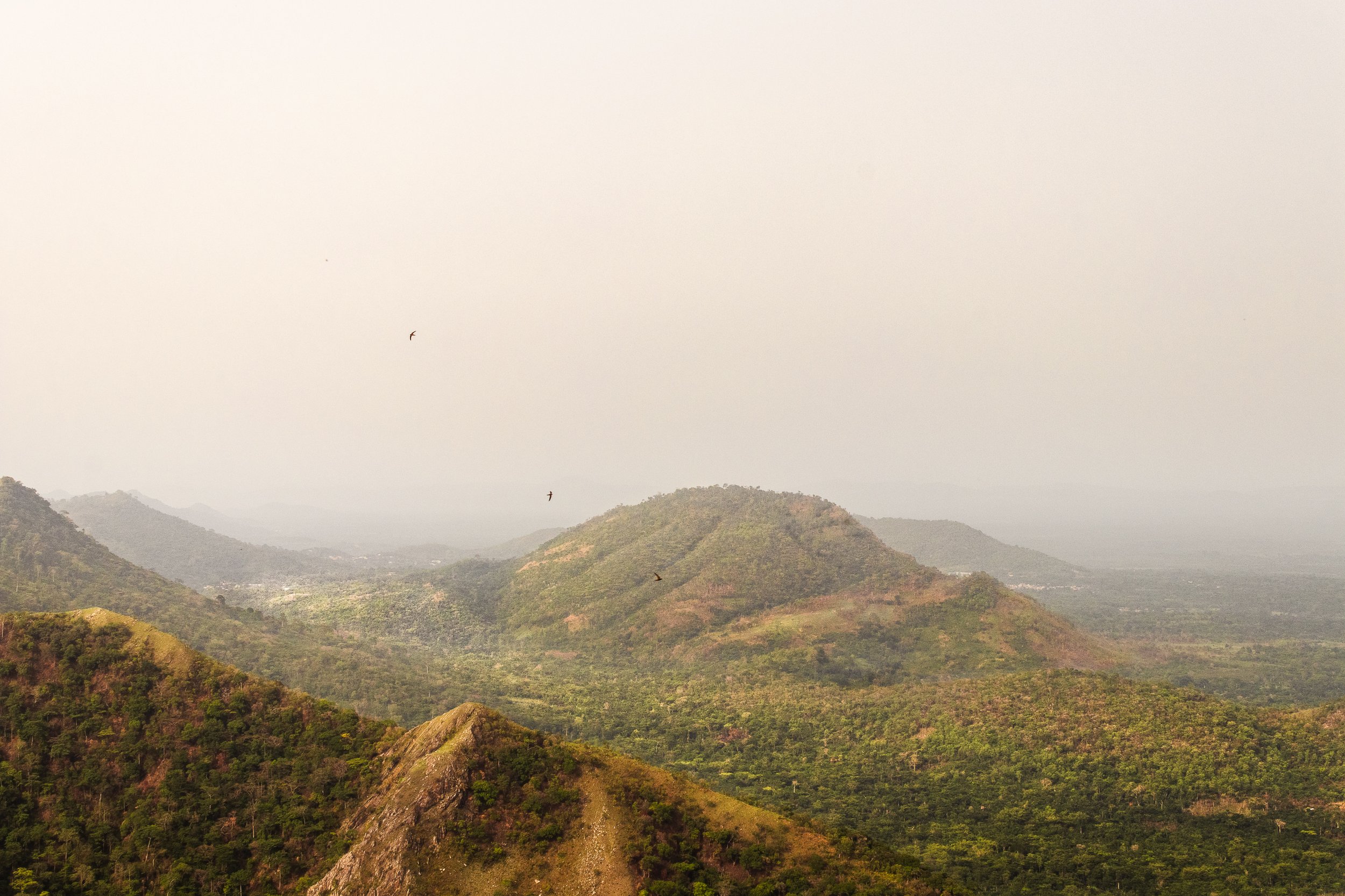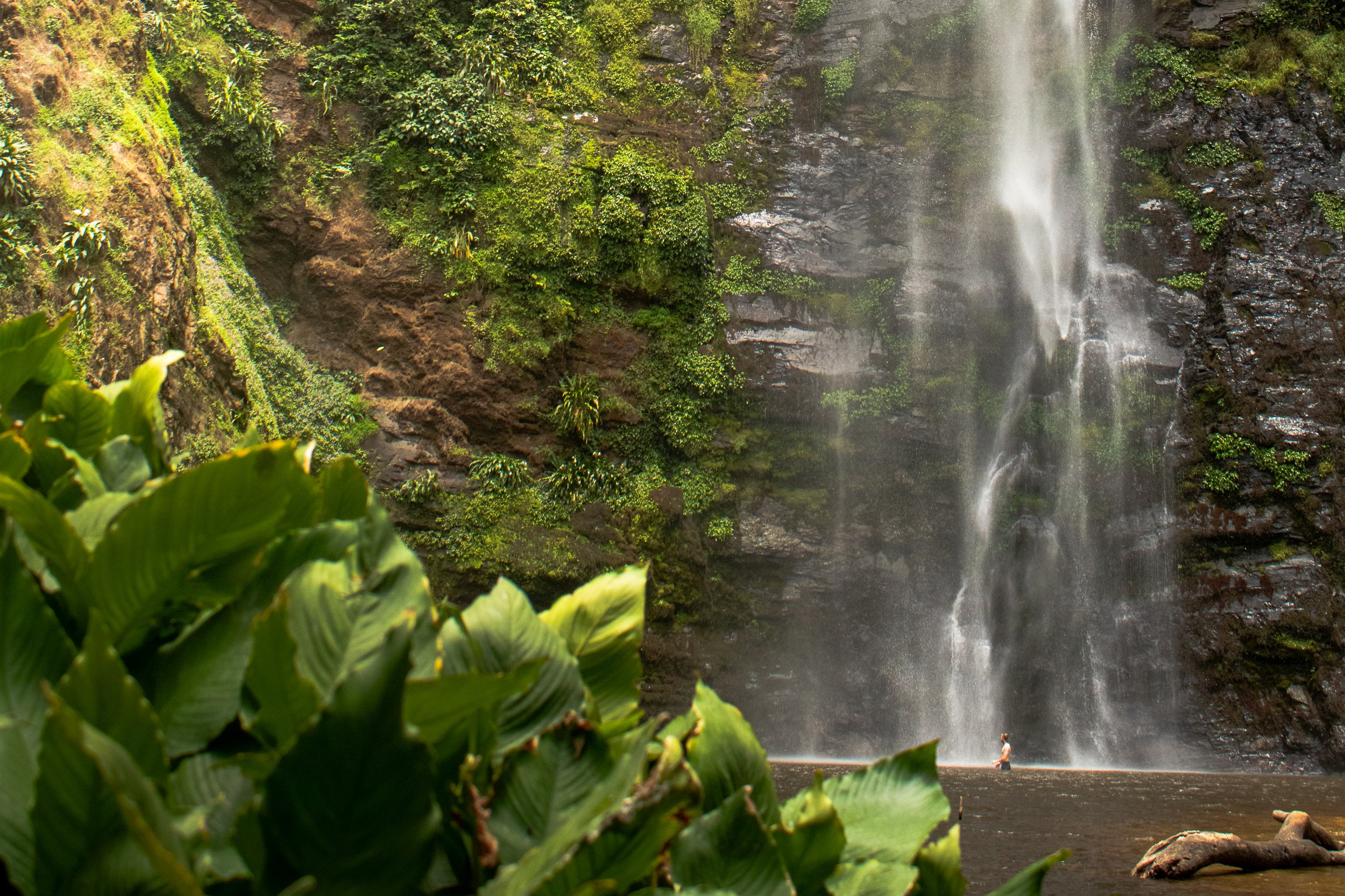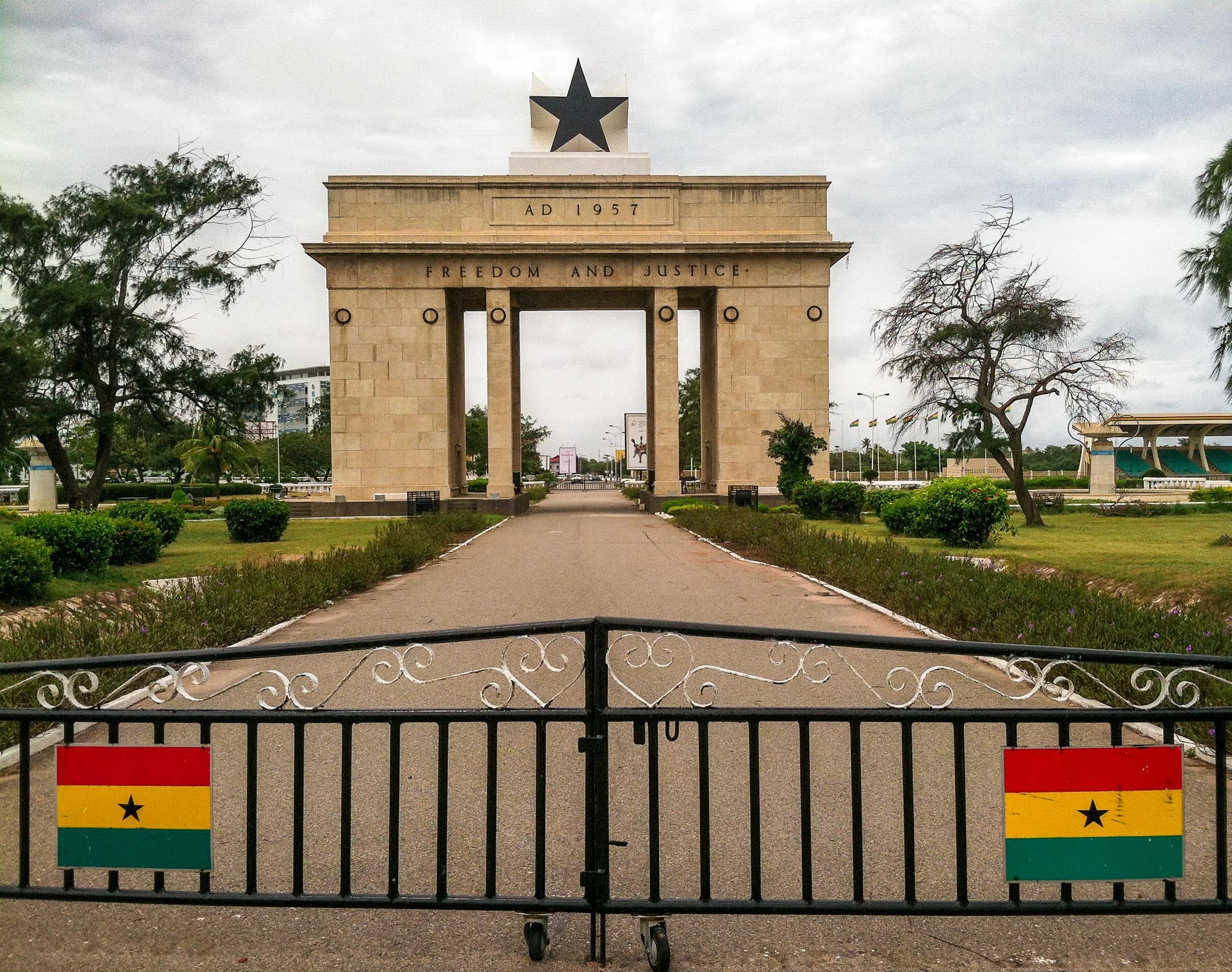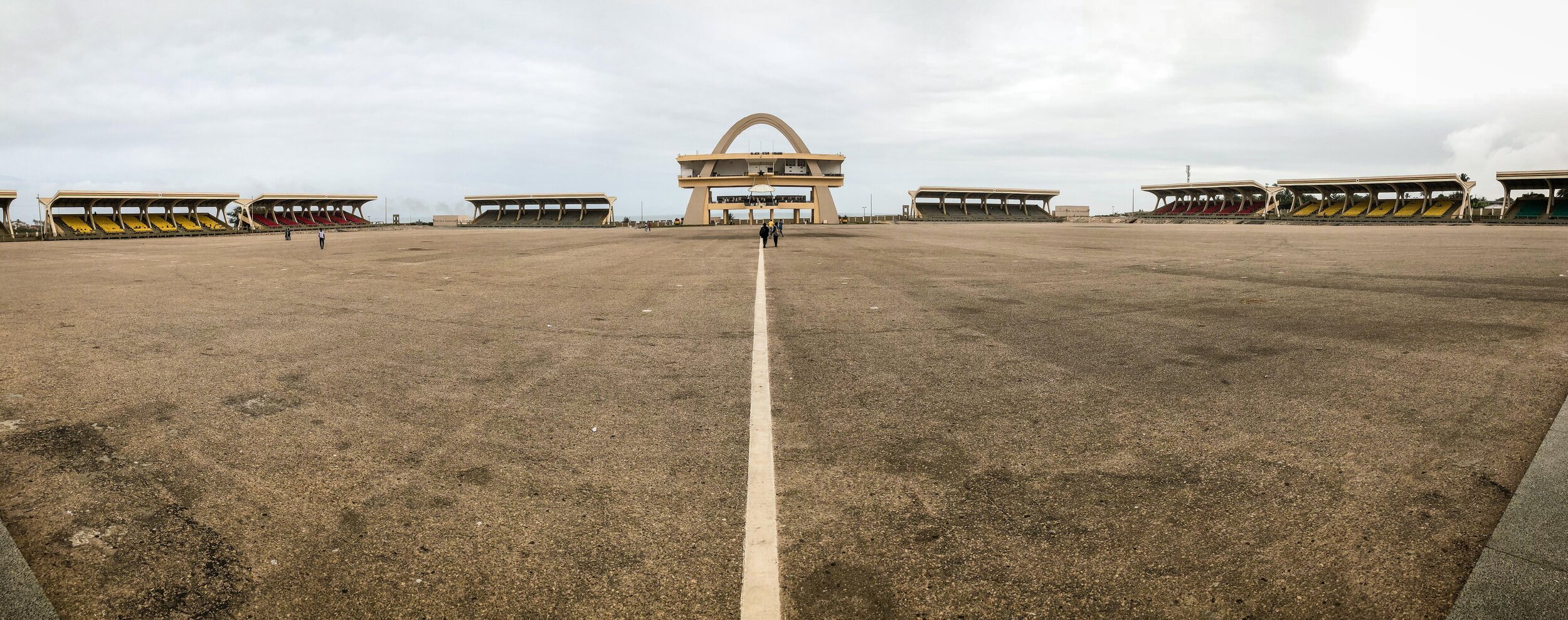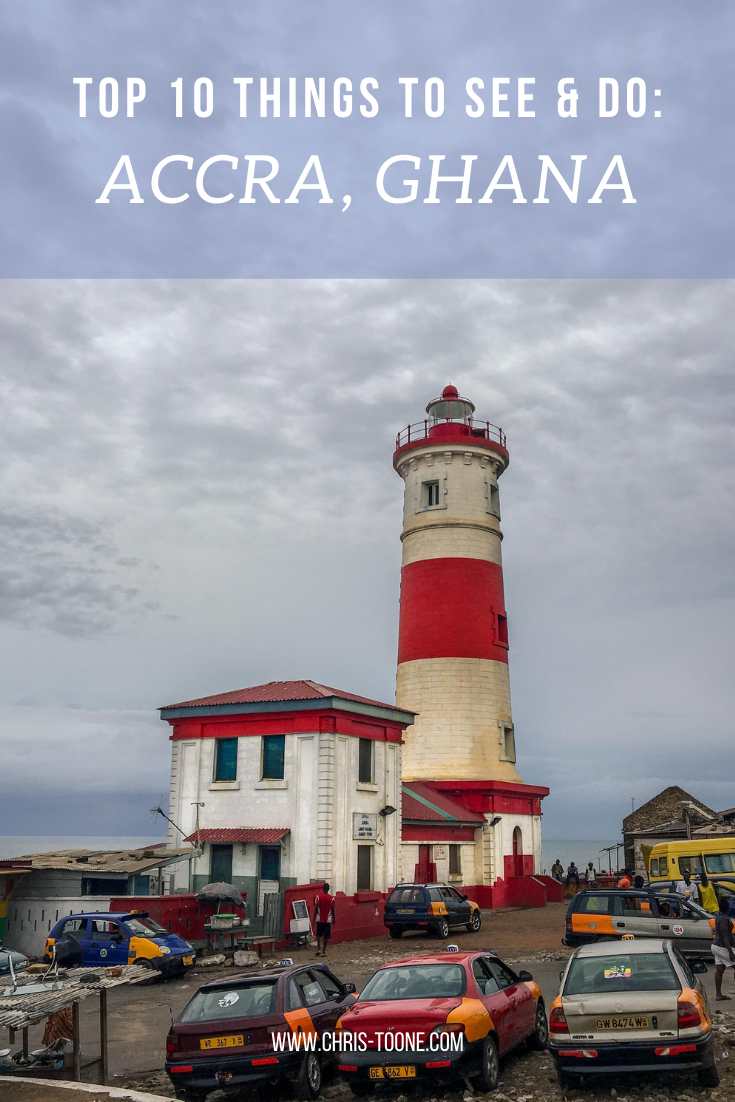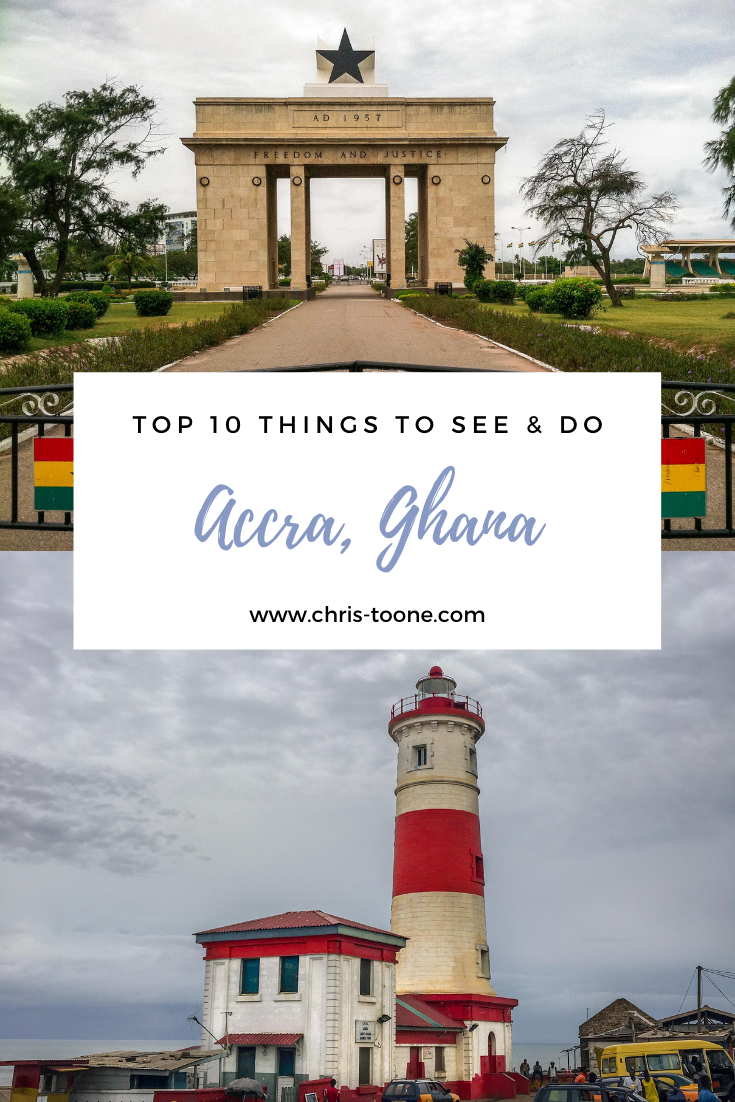Climbing Mount Afadjato: A Complete Guide to Hiking Ghana's Tallest Mountain
If you’ve been on this blog before, it’s no surprise that this is yet another post about the unbelievable nature of Ghana’s Volta Region. When I first moved to West Africa, I immediately searched for “top places to hike in Ghana,” and every result pointed back to this mountain. So naturally, the surrounding forests and waterfalls of Mount Afadja have become my safe haven…
Note: All information below is accurate as of April 2025
If you’ve been on this blog before, it’s no surprise that this is yet another post about the unbelievable nature of Ghana’s Volta Region.
When I first moved to West Africa, I immediately searched for “top places to hike in Ghana,” and every result pointed back to this mountain. So naturally, the surrounding forests and waterfalls of Mount Afadja have become my safe haven.
Standing at 885 meters (2,904 feet), Mount Afadjato is Ghana’s tallest mountain and offers stunning views of surrounding villages, verdant forests, and even neighboring Togo.
Even more, it’s located in a small, peaceful village with plenty of other trails and waterfalls to explore, including my favorite place to stay: Tagbo Falls Lodge.
Fancy a bit of outdoor adventure on your trip to Ghana? Mount Afadjato is for you!
The view of the Volta Region while hiking Mount Afadjato in Ghana
History and meaning of Mount Afadjato
Mount Afadjato derives its name from the Ewe word “Avadzeto,” meaning “at war with the bush.”
As the Ewe tribe settled here from Togo, they were prone to attacks from wild animals. The village revolted, pushing them back into the mountains but as they reached the forest, they were overcome by plants making them itch.
Afadja, Afadjato, it’s all the same! Another way to break it down in the Ewe language: ‘Afar’ means ‘war’, ‘dja’ means ‘plant’, and ‘to’ means ‘mountain.
Despite the name and history, I’m happy to report that the itching plants have since been tamed and it is very safe to hike the trails (but consider long pants, just in case)!
The area remains a symbol of pride for the Ewe people, as Mount Afadja is believed to house the spirits of their ancestors who look over and protect the surrounding communities.
Interested in exploring more of Ghana’s Volta Region? Check out these posts:
Location and how to get to Mount Afadjato
Nestled in the mountains that border Togo, the trailhead is located in the small village of Liati Wote in Ghana’s Volta Region. Sounds great, right? Here’s how to get to Mount Afadjato:
By Car: From Accra, take the Accra–Hohoe road and follow signs to Liati Wote. The roads are well-maintained (for the most part), making the drive smooth and scenic as you wind through the mountains. The drive should take ~6 hours.
By Public Transport: Buses and shared taxis from Accra to Hohoe are affordable. From Hohoe, hire a taxi or take a shared ride to Liati Wote. Another option is to take a tro-tro to Golokwati, but this often requires 2-3 changes in vehicles along the way.
From Nearby Attractions: If you’re already exploring Wli Waterfalls or Tafi Atome Monkey Sanctuary, Liati Wote is just a short drive away (20-40 min depending on where you’re coming from).
If you don’t want to plan your own transportation, consider one of these pre-arranged tours from Get Your Guide. They depart Accra and sort travel, food, and accommodations along the way!
Pro Tip: Whenever I can, I try to travel around Ghana on Sundays. Everyone is in church and this means much less traffic and dangers on the road – and I get to where I’m going quicker! I have my own car, but your safest option is to either rent or hire a reliable taxi. Although cheap, tro-tros (Ghana’s public transportation) are prone to breakdowns and accidents.
Aerial view of Liati Wote as seen from the trail of Mount Afadjato in Ghana’s Volta Region
Entrance fees & costs
Liati Wote markets itself as a tourist village (don’t worry, I was initially turned off by this as well, but it’s not what we’re used to when we see that tagline).
There are plenty of tours and options available around town, including multi-day hiking, local gin tours, and surrounding waterfalls, but be warned that each one requires a guide (this is used as a means to boost the local economy).
You can find a guide and look at the options available by checking in at the Liati Wote Toursim Office upon arrival, located at the base of Mount Afadja on the main road of town and typically open 8am, daily.
The tourism office accepts cash only, so come prepared as there are no ATMs within a one hour radius.
Hiking only Mount Afadjato requires a modest fee:
Ghanaians: 25 GHS (USD 1.60)
Non-Ghanaians: 50 GHS (USD 3)
You can add on and combine with a trip to Tagbo Falls (GHS 40/USD 2.50 for Ghanaians, GHS 80/USD 5 for non Ghanaians), or continue past Mount Afadjato to Mount Aduadu (GHS 70/USD 4.50 for Ghanaians, GHS 100/USD 6.50 for non-Ghanaians).
A Note on Guide Fees: Guides for hiking Mount Afadjato and surrounding tours don’t get paid from trail fees, so come prepared to tip them for their service to support their income. For this hike, GHS 50-100 is reasonable (USD 3-6).
The trail fees do, however, contribute to maintaining the paths and supporting local community projects, such as their recycling initiative – something that is unique to this village!
Pro Tip: There are many guides and not many visitors, meaning it’s important to find one of quality. The only one I’ll use is Faith (+233 55 083 0914). I will meet him at the reception office, pay the entrance fee, give him a tip, and often he’ll let me take myself on the trail!
What to Expect: Hiking Mount Afadjato
Although Mount Afadjato is considered a popular tourist destination in Ghana, let me be direct with you: It’s not for everyone. The trail starts on a flat path, but quickly becomes a leg burner, what feels like a perpetual stair climber machine.
Most people will tell you it takes, on average, around 2 hours round trip, which I found to be accurate, but it was by no means easy. It’s important to wear sturdy shoes and bring plenty of water and fuel.
Along the way you’ll come across convenient rest stops with scenic views, offering the perfect spot to recharge your legs and observe surrounding wildlife.
Did you know that Ghana is home to over 860 species for butterflies? Don’t worry, I didn’t before moving here, but spotting them is one of my favorite parts of spending time in the Volta Region!
Finally, after 45min-1 hour you’ll reach the peak and soak up the sweeping views across Lake Volta, neighboring Togo, and Liati Wote below. You may even spot Togolese coffee farmers wandering the foohills!
The Volta Region is where both Kawa Moka and Jamestown, two of Ghana’s top coffee companies, produce their beans.
For the most part, the trail is well preserved and shorts and t-shirt will suffice, but if you’re planning to go beyond the peak to nearby Mount Aduadu as I did, be sure to wear long pants.
Reaching this secondary mountain requires bushwhacking lesser-frequented pathways and it’s not uncommon to come across snakes and biting ants.
View of Mount Aduadu at sunrise, shot from the peak of Mount Afadjato
Nearby attractions
Tagbo Falls: Located near Mount Afadjato, this tranquil waterfall is an excellent spot to cool off after your hike. I’d recommend climbing Afadja in the morning, and then continuing on (for an additional trail fee) to Tagbo Falls. It’s a flat, short, 40min hike and the trailheads start from the same location! It’s one on my favorite places to spend an afternoon swimming.
Wli Waterfalls: Ghana’s highest and most famous waterfall is just a short drive away (20min) and offers another fantastic nature experience. Similar to Tagbo, this short trail is accessible to everyone and cooling off in the pool under the cascading water is a spiritual experience.
Amedzofe Village: Amedzofe is Ghana’s highest-elevated settlement, originally established by the Germans during colonial times. The area offers cooler weather, more waterfalls, a better (and less frequented) canopy walk than Kakum National Park, and a small climb to the cross on top of Mt. Gemi. If coming from Ho, you’ll pass the turnoff for Amedzofe along the way (less than 1 hour from Liati Wote).
Best time to hike Mount Afadjato
The Harmattan, or dry season, (November to April) is the best time for hiking, as the trails are less muddy. However, the dust being blown from the Sahara can significantly reduce visibility (although makes for beautiful, glowing sunrise).
The rainy season (May to October) brings lush greenery, making the scenery even more vibrant, but the steep trail can get slippery, so be sure to wear proper footwear and plan accordingly.
Finally, beat the heat and hike Mount Afadjato in the morning. If arranged ahead of time, your guide can meet you at the tourist office before sunrise and you can start on the trail before fighting the humidity.
Top packing tips for your hike to Mount Afadjato
Shoes are essential. Especially if planning to visit during rainy season. The trail is steep and can quickly become slippery, so it’s safest to have good treads.
Sunscreen and insect repellent. The trail itself traverses dense forest, and the peak is completely exposed so you’ll have to plan for all elements. After years of sweating off my sunscreen in the humidity, I’ve finally switched over to using a stick instead and it’s been a gamechanger!
A good camera. The top of Mount Afadjato provides some of the most stunning views in the area. If you’re into landscape photography, this is the place to come. Personally, my Canon 80d has been my best travel companion over the years.
A quality dry bag. Hiking in West Africa can be unpredictable, especially during the rainy season. I’ll always bring my Marchway dry bag to protect my valuables.
Don’t forget a quick-dry towel. Whether caught in the rains or planning to add on a visit to Tagbo Falls, a lightweight towel is the perfect item to add to your pack.
Water and Fuel. Regardless of season or time of day, you’ll work hard to get to the top of Mount Afadjato. Come prepared with plenty of water and snacks. There aren’t many options available in town, but you can always also your guide where to pick up supplies.
A reliable SIM card. Traveling outside of Accra is never easy and it pays to have a reliable in-country SIM. Recently, I’ve been using Airalo on my travels and, although I enjoy collects SIM cards, they take away the stress of losing it or always looking for a pin to open the port!
A view into the valley below, shot from the peak of Mount Afadjato
Standing on top of Ghana’s tallest mountain at sunrise is a scene I won’t soon forget. Accra is great, but experiencing the breathtaking nature in the Volta Region is a must during any visit to Ghana, and Liati Wote is the perfect place to base.
Explore, rest, and walk away refreshed from your time in these stunning mountains.
Have you conquered Mount Afadjato or plan to visit? Share your experience in the comments below. As always, stay safe and happy travels!
Sharing is caring! Pin this post for later.
A Complete Guide to Visiting Wli Waterfalls in Ghana
Hidden in the lush greenery of Ghana's Volta Region lies a breathtaking natural wonder, offering an unforgettable experience for nature lovers and adventure seekers alike. Here’s your ultimate guide to making the most of your visit to Wli Waterfalls…
Note: All information below is accurate as of March 2025.
If you haven’t caught on yet, I’m a big fan of the nature in Ghana and, after moving here, I was surprised to learn that the highest waterfall in West Africa is only a short day-trip away from my home.
Hidden in the lush greenery of Ghana's Volta Region lies a breathtaking natural wonder, offering an unforgettable experience for nature lovers and adventure seekers alike.
Here’s your ultimate guide to making the most of your visit to Wli Waterfalls!
Ghana’s Volta Region is full of lush mountains along the border with Togo
Know Before You Go: Wli Waterfalls Background
Wli Falls, also called Agumatsa Falls, means "let me flow" in the Ewe language. The falls are fed by the Agumatsa River, which comes from neighboring Togo, and plummets 80 meters over the cliffs and into the pools below.
Although a popular tourist spot, the surrounding nature is still relatively untouched, making for a serene and peaceful day in the forest. You’ll run into colorful butterflies, plenty of birds, and even a colony fruit bats along the cliffs.
So, now that you’re hooked, when’s the best time to visit Wli Waterfalls? Well, there are two options that depend on what your priority is.
Dry season in Ghana, also known as Harmattan, runs from November to March. During this time the hiking weather is more pleasant, but the flow of the falls will be slower.
In contrast, rainy season occurs from April to October and makes the hike a bit more difficult with muddy trails, but you’ll get to experience the roar of the waterfalls at full force. Personally, I’d choose the rainy season, but it’s a great place to spend an afternoon either way.
Finally, it’s important to be aware that there are two trails: one to lower falls, and one to upper. The lower trail is classified as easy and good for all ages, while the upper falls trail is moderate to hard and requires a guide (these can be found at the main office).
Choose your adventure and plan accordingly!
Standing beneath Ghana’s Wli Waterfalls
How to get to Wli Waterfalls
Wli Waterfalls is located near the town of Hohoe in Ghana's Volta Region and is most easily accessible by car from Accra. The good news is that, unlike other regions of Ghana, the roads in and out of the waterfall area are well maintained, making for a breathtakingly beautiful drive along the mountainous border with Togo.
To get here…
By Car: From Accra, it’s about a 4-5 hour drive (approximately 230 km). The route takes you through scenic landscapes and vibrant local villages. The biggest places to stop for petrol along the way are Atimpoku, Juapong, and Peki (if passing through Golokwati).
By Public Transport: Take a bus or shared taxi from Accra to Hohoe, then hire a taxi or moto to Wli, which is about 20min away.
Pro Tip: Share a taxi for the day or hire your own car. Local minibus transportation, also known as tro-tros, are notorious for accidents and breakdowns, especially when covering longer distances outside of Accra.
Entrance fees & costs
For a comprehensive list of admittance fees, including child and student discounts, visit the official Wli Waterfalls website.
Entry Fee (Lower Falls):
Ghanaians: 25 GHS (USD 1.60)
Non-Ghanaians: 60 GHS (USD 4.00)
Upper Falls Guided Hikes:
Ghanaians: 60-70 GHS (USD 4.00-4.50)
Non-Ghanaians: 80-90 GHS (USD 5.00-6.00)
Bring extra cash for souvenirs, snacks, or donations to support the local community. A small market is setup outside of the Tourism Office, making it easy to stock up on water and other supplies.
Pro Tip: Remember to tip your guide and get their contact information to recommend their services to others. Ghana’s economy functions off connections and who knows who, so this small gesture will go a long way.
Interested in exploring more of Ghana’s Volta Region? Check out these posts:
What to expact at Wli Falls
Lower Falls
A gentle, 30-minute walk through Ghana’s lush nature on a well-marked trail leads to the lower falls. You’ll cross scenic wooden bridges and enjoy the vibrant sights and sounds of the rainforest. The cascading waters create a refreshing natural pool perfect for a swim.
You’ll hear the falls before you can see them and pay close attention to the towering cliffs as they come into view between the tree-tops. This is where the fruit bat colony resides and, if you’re lucky, you’ll catch them flying off the rocks
Upper Falls
For a more challenging adventure, embark on a steep 3-4 hour hike to the upper falls (guide required). The trek rewards you with stunning views and a quieter, less-crowded experience. There is both a short loop and a long loop, so be sure to discuss with the Tourism Office before setting out on your adventure.
Unlike Lower Wli Falls, the Upper requires hiking through grassy foothills and on narrow paths, so be sure to bring appropriate footwear and long pants. A moderate level of fitness is required for this trail.
Pro Tip: To avoid the crowds, plan your visit for a Sunday morning. This will ensure you beat the post-church rush and as they move in, you’ll be on your way back out!
Swimming in the pools beneath Wli Falls in Ghana
Nearby places to visit
The Volta Region is full of amazing nature and experiences, so make your trip even more memorable by exploring more near Wli Waterfalls:
Amedzofe Canopy Walk: A short 1 hour drive away, Amedzofe is the highest elevated settlement in Ghana and is where you’ll find a canopy walkway with the stunning Oti Falls as a backdrop.
Mount Afadja (Afadjato): Ghana's tallest mountain offers a thrilling hiking experience and panoramic views in neighboring Liati Wote.
Tagbo Falls: Another serene waterfall located near Mount Afadja, perfect for a peaceful escape and my favorite place to soak up Ghana’s nature.
What to bring
Hiking Boots: Especially if hiking the Upper Falls or visiting in rainy season.
Swimsuit and Towel: Even if you don’t plan to swim, still bring it. The swimming pools act as a great way to cool off from Ghana’s heat and humidity! Pack lightly with a quick dry towel.
Waterproof Bag: Protect your valuables and be sure bring a waterproof bag, especially if there’s a risk of rain! I never hike in Ghana without my Marchway dry bag.
Water and Snacks: Wli Waterfalls is located within the Agumatsa Wildlife Sanctuary, so although these items are easily accessible at the trailhead, please remember to pack out what you bring in!
A Good Book: What better way to recharge then lounging at the base of West Africa’s tallest waterfall and enjoying a good book. Ever since moving abroad and traveling more extensively, I never leave home without my Kindle Oasis.
A visit to Wli Waterfalls is more than just a trip—it’s an immersion into Ghana's natural beauty and cultural richness. Whether you’re splashing in the lower falls or hiking to the upper falls, you’ll leave refreshed and ready for more of all Ghana has to offer.
Have you visited Wli Waterfalls or plan to go? Share your thoughts in the comments below!
Sharing is caring! Pin this post for later.
Top 10 things to see and do in Accra, Ghana
From historical monuments to bustling markets, Ghana's capital city of Accra has plenty of diverse experiences to offer. Here 10 of the top things to see and do... enjoy the adventure!
Please note: This post has been updated as of December 2023
Approximately the size of Texas, Ghana encompasses an arid climate up north, rainforests in the south, sunny beaches, diverse religions, rich culture, and more than 250 dialects.
So, how can one possibly get a beat on all that this West African nation has to offer? Start with Accra; the place where it all melds together in joyful harmony.
Here are 10 of the top things to see and do in Accra, Ghana!
1. LOSE YOURSELF IN ALLEYS OF MAKOLA MARKET
Largely considered as the economic heart of Accra, Makola Market can be overwhelming to first-time visitors, and for good reason.
There is no official welcome sign or arrows that guide visitors to the various subsections, rather the city’s streets quickly transition from flowing traffic to full of pedestrians and goods. Rest assured anything you might need can be found: a toothbrush, sunglasses, veggies, smoked fish, soap, second-hand clothing, and even toys and souvenirs.
Personally, my favorite thing to do here is to track down a bofrot vendor, Ghana’s version of a donut, and munch on the delicious snack as I wander through the streets in search of something new.
It’s important to remember that although Ghana is commonly referred to as “Africa for beginners” crime still exists, especially within such a high density of people. Be sure to keep your belongings close to avoid pickpockets and keep in mind that all legitimate business is done out in the open. There’s no need to wander into back alleys or enclosed spaces.
Finally, enjoy it.
It can certainly be a bit overwhelming to first-time visitors, but don’t let that deter you but don’t let that keep you way. Rather, use Makola Market as a sort of “right of passage” to truly experience the local life in Accra. It’s something that everyone should experience at least once, even if just for a moment.
Don’t forget to negotiate your purchases - that’s half the fun!
A small section of the bustling Makola Market in the heart of Accra, Ghana
2. STROLL THROUGH THE KWAME NKRUMAH MEMORIAL PARK
Kwame Nkrumah Memorial Park was dedicated to the first Prime Minister of Ghana in 1992 and is located on the site of the former British polo grounds. This is the exact spot where Dr. Nkrumah once stood to declare Ghana’s independence from British rule before uttering his famous line: “Ghana is free forever”.
A mausoleum is located within the park’s walls and holds the remains of Dr. Nkrumah and his wife, Fathia. To the naked eye, the exterior seems an odd architectural design, but to the people of Ghana, it was built to resemble an upside-down sword, the Akan symbol of peace.
In total, the park covers 5.3-acres and also encompasses a museum which houses photographs, letters, and more from Dr. Nkrumah’s storied life.
It’s easy to spend a couple of hours here, soaking up the palpable history of the long and grueling fight for freedom. A powerful experience, to say the least, and one of the most important sites for first-time visitors to Accra!
3. PAY A VISIT TO BLACK STAR SQUARE
Black Star Square is a massive open-air arena of sorts in the heart of Accra that accommodates 30,000 people. It now hosts all of Ghana’s national parades and holiday gatherings, most notably the Independence Day celebrations held on March 6th each year.
This architectural giant was originally commissioned by Ghana’s first Prime Minister and President, Kwame Nkrumah, to honor the visit of Queen Elizabeth II in 1961.
The expansive area includes Independence Arch on the southern end of the square with the Gulf of Guinea as a backdrop while the Memorial of the Unknown Soldier stands opposite to the north, honoring all of the fallen souls during Ghana’s fight for independence.
By day the square is empty, showing off its sheer size to all who visit. There is no entry to fee walk around and photographs are generally permitted, however keep an eye for guards standing around any of the specific monuments, most frequently Independence Arch. At that point it’s best to exercise your travel photography etiquette and ask before taking a close-up photo.
A visit to Black Star Square certainly won’t take long, but it’s a convenient stop that’s located near several other points of interest, including Black Star Gate and Accra Sports Stadium.
An empty Black Star Square looking towards
4. CLIMB TO THE TOP OF BLACK STAR GATE
Technically part of the Black Star Square complex and sometimes referred to as Independence Arch, this stunning gate stands alone in the middle of a roundabout on the 28th of February Rd. (named out of respect for the 1948 riots) and is impossible to miss.
Lined with beautifully planted gardens, the Black Star Gate represents the struggle for Ghana’s independence. The star at the top, not unlike the one that can be found at the center of the country’s flag, dons the top of the structure on all four sides and symbolizes African emancipation.
The other colors of the flag, red, yellow and green, represent the blood of those who died for independence, mineral wealth, and Ghana’s rich forests and natural resources, respectively.
Be sure to climb to the top of the Black Star Gate and take advantage of the spectacular city views across Accra. This is a great photo op for an aerial perspective over the massive Black Star Square, Accra Sports Stadium, and Osu Castle.
Although it’s free to do, I’d recommend tipping the guide that escorts you up.
Black Star Gate in downtown Accra, Ghana
5. GO BACK IN TIME AT OSU CASTLE
Once referred to as Christiansborg, Osu Castle is now a UNESCO World Heritage Site and stands on the shores of the Atlantic Ocean, serving as a constant reminder to Ghana’s gut-wrenching past.
Over the years, control of the castle changed hands between the Danes, Norwegians, Portuguese, and British and even served as the seat of the Ghanaian government in the post-slavery era up until it was moved to its current location at the Jubilee House in 2013.
Today, the castle offers visitors the chance to wander the halls British officials once walked and explore the harsh conditions of the slave dungeons.
The most meaningful experience, however, is the solemn “Door of No Return,” ominously named to symbolize the final time that those held captive would step foot on their native soil before boarding a ship bound for the New World.
It’s worth a visit, especially if you don’t have the time to travel to Cape Coast’s castles. Keep in mind that Osu Castle remains within a security zone and, as a result, is only open to the public on Fridays between the hours of 9:00 am and 4:00 pm.
6. WATCH A SOCCER MATCH AT ACCRA SPORTS STADIUM
The Accra Sports Stadium is a 39,800 seat facility that’s mostly used as the home venue for the Hearts of Oak and Accra Great Olympics F.C. soccer teams of the Ghana Premier League.
Although an upbeat atmosphere accompanies match day, it doesn’t come without its fair dose of unfortunate history.
In 2001, it was the site of the worst stadium disaster in all of Africa that claimed the lives of 126 fans. On that fateful day, Hearts of Oak was playing in a match against Asante Kotoko and trailed 1-0 until two quick goals changed their fortune.
Disappointed Kotoko fans responded by throwing plastic bottles on the pitch before law enforcement retaliated with tear gas. Due to the stadium’s poor design, fans bottlenecked at the limited exits and 116 supporters died of compressive asphyxia while another 10 passed away from trauma.
Today, a bronze statue of a fan carrying another fan to safety stands proudly outside of Accra Sports Stadium and reads “I am my brother’s keeper.”
Attending a professional match here remains one of my all time favorite experiences in Accra. In all honesty, I don’t remember how the game unfolded. We were too busy singing, dancing, and blowing vuvuzelas in the rain with the diehard supporters.
Accra Sports Stadium and home of Hearts of Oak, the most successful club soccer team in Ghana
7. JAMESTOWN LIGHTHOUSE
The 92 ft tall Jamestown Lighthouse was built in the 1930s and stands as an iconic staple of the Jamestown neighborhood, which was once a major settlement of Europeans during the slave trade.
Although no longer operational, it’s still possible to climb to the top and take in the fresh air the blows in off the Gulf of Guinea while overlooking the fishing village, historic Fort James, and surrounding Accra.
Pay close attention to where slabs of cement jut out into the ocean. That’s where slaves once walked en route to ships bound for the New World.
The lighthouse is kept under lock and key by local volunteers. They represent a non-profit organization that works in the area and although the building is technically free to visit, it is expected that you provide a donation for their willingness to guide a short tour.
They may try to encourage you to visit Fort James and the fishing village as well, but it’s okay to say no. Simply donate a comfortable amount (5 GHC per person usually suffices) and continue on your way!
Jamestown Lighthouse standing tall in Accra, Ghana
8. KICK BACK AND RELAX AT LABADI BEACH
Adored by locals and foreigners alike and commonly referred to as “La Pleasure", Labadi Beach is a scenic stretch of sand in the Labadi neighborhood of Accra.
Visit during the day and enjoy the views as you sip on a local beer while waiting for your fresh fish at one of the various stalls before wading into the waves. Grilled tilapia, spicy kebabs, and jollof rice are just a few of the dishes available.
Once the sun goes down, the music turns up and the party begins! It’s not uncommon to find reggae artists, disco DJs, and other live bands blasting a cacophony of sounds late into the night.
As you might imagine, a large part of Accra turns up on the weekends, so for a more relaxing experience, it’s best to visit during the weekday. Either way, the small entrance fee (around 20 GHC) is worth the price!
9. SHOP ‘TIL YOU DROP AT THE CENTER FOR NATIONAL CULTURE
Although the Center for National Culture may sound like a museum of sorts, it’s actually a souvenir mecca. From wood carvings to backpacks made with the traditional kente cloth, jewelry, gorgeous canvas paintings, and even musical instruments, these vendors have it all - and they’re not afraid to tell you about it!
Don’t be surprised to find yourself surrounded by new “friends” the moment you step out of the taxi, eagerly ushering you to their respective shops. Stand your ground, tell them you’ll stop by later, and stick to your plan.
Right away you’ll notice that the market is inundated with lookalike items, which quickly explains everyone’s urgency to sell their version. My best advice is to take a lap: slow enough to get eyes on what’s available, but quick enough to avoid any aggressive selling strategies.
Another useful tactic is to use your instincts and make a friend. Spend some time talking, build trust, and ask for advice as to how much the items around the market that peaked your interest should cost. It makes the ensuing negotiations much easier!
An artisan delicately carves a bowl at the Center for National Culture in Accra, Ghana
10. HEIGHTEN YOUR SENSES AT THE ARTISTS ALLIANCE GALLERY
Three stories of unique artwork and crafts fill the halls of an old tower that overlooks the Gulf of Guinea.
The Artists Alliance Gallery was first established by the famous artist, Ablade Glover, and has since grown to include the work of both well-known but also up and coming artists of Ghana.
From woven kente cloth pieces to vibrant canvas paintings, a wide array of eye-catching visuals are available to peruse as well as purchase.
Pay special attention to the exorbitantly carved coffins in the shape of crabs or a pair of Nike shoes. In Ghana, it’s popular in to bury a loved one in something that represents their being - whether depicting a favorite item or former occupation.
Admission is free and it makes for a great afternoon of embracing the vibrant and artistic culture of Ghana!
So, there you have it. It’s time to get out and explore Accra, Ghana!
What interests you most on this top 10 list? Is there something I’ve missed? Let me know in the comments below!
As always, stay safe & happy travels.


